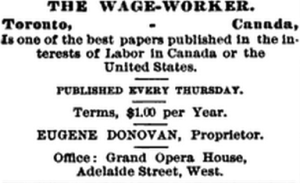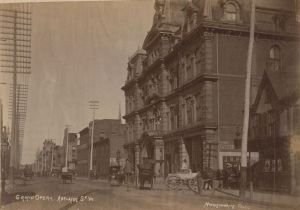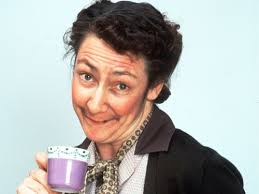Banner photo is 229 and 231 Queen St W in 2015. Photo by K Taylor.
To the many who loved it (and here I mean me), Queen W. is no longer the strip it once was. The Queen W of my teens and early 20s was a colourful street, with the stretch between Bathurst and Simcoe the choicest. Studded with ragtag vintage clothing and record stores, my friends and I would traipse up and down it for hours on end. In those halcyon days there was even an honest to goodness diner – The Stem – which, like the street, sat suspended in a time generations before our own. Sometime over the past decade and a bit, that tenuous suspension broke at the intersection of Spadina and Queen and a flood washed much of what was delightful away. Perhaps I’m taking something from those who throng the street now, but I just don’t see getting het up about large chain stores and a Carl’s Jr.
Now that that’s off my chest, let me tell you about a pair of stores that have managed to hold on. Kops Records and the Condom Shack have marked the eastern border of the fun part of Queen W (that is, before you enter the Eaton’s and Hudson’s Bay department store zone) for as long as I can remember. The delightful buildings themselves date from the 1880s and are about as true to the old Queen W. as you’re likely to find today.
This cheerful pair sits near the SW corner of Queen and Simcoe which was once just a stone’s throw from the western border of The Ward. Officially named St. John’s Ward, the area ran east from University to Yonge and north from Queen to College. Home to the city’s poorest immigrants, who were drawn by the cheaper rent, it was already a fairly well-established slum by the 1850s. As is too often the case, these vulnerable new Torontonians were preyed upon by landlords who over time carved up the apartments, raised the rent and kept the properties in deplorable conditions. Families, struggling to meet rent hikes, were forced to bring more and more people into their meager rooms and unimaginable numbers crammed the dismal spaces.
St. John’s Ward may have had clear boundaries but the surrounding area bore the mark of the people who struggled within it. Look back at this slice of Queen, between Duncan and Simcoe, and you’ll find you’re seeing the Ward peripherally. Predominantly an Anglo street from the 1850s to the 1880s, the street saw a great influx of Jewish, Chinese and Italian businesses in the mid-1890s, mirroring the waves of immigrants who were settling in the Ward. Where once it was Grahams, Spences and Armstrongs, there were now Robinowichs, Chongs and Castruccis.
The tenant history of 229 Queen W alone, now Kops Records, shows just how much movement there was in the area. Originally the home of C. Lorden, an officer at the Customs House, it eventually became a retail address and changed hands almost yearly. As a store-front, it was first the Price Brothers Tailors (1884), followed by Mrs. Wrigley’s Millinery (1885), M. Gordon’s Second Hand Goods (1888), John Tuite’s Cigars (1889) and Joseph Helman’s Furnishings (1890). In 1893 it once again became a home – this time for a man named Eugene Donovan. He was listed simply as a printer but, naturally, there was a bit more to his story than that.
Donovan had been the editor of a paper called The Trade Union Advocate, but which he later renamed The Wage Worker in 1883, after joining the Knights of Labour group. The paper’s mission was to “agitate, educate and organize.” Furthermore, Donovan felt the paper “ought to embrace the rights, the wrongs, and the material interests of all who earn their livelihood through the sweat of their brow.”

As we can see from the ad above, The Wage Worker came out of an office in the Grand Opera House – which seems a bit odd. At the time, the Grand Opera House was in its heyday (the Burlesque shows would come later) and had giants such as Oscar Wilde, Sarah Bernhardt and Maurice Barrymore stride across its stage. So the idea of Eugene Donovan toiling away on a labour paper in an upper room fascinates me.

Sadly, by the time Donovan moved into 229 Queen W. in 1893, the Wage Worker had folded. In the intervening years, he’d had a stint working at The Mail, one of Toronto’s larger newspapers and, surprisingly, as a confectioner. Though he was once again listed as a printer at 229, there’s no mention of what it was he printed.
In 1900, a few years after Eugene Donovan had moved on, 229 Queen became Charlie Hing’s Laundry. In keeping with the building’s past, it quickly changed hands again, becoming Lee Jung’s Laundry and then Jaing Sing’s after that. I have to note here that these records represent the Might City Directory at its best. They may have occasionally bungled names but they seem to have tried their best to record them for each address. But then abruptly, in 1908, they simply stopped listing Chinese names altogether. What had once been an individual’s home or business, like any other, was now relegated to one of two descriptions: “Chinese Laundry” or “Chinese Restaurant.” Well, I shouldn’t say always. One exception is the entry for nearby 213 Queen W. in 1922 where the listing was simply “Foreigners.”
Through all the comings and goings at 229, and really everywhere else along the block, there was one resident who stayed firmly planted. In 1890, a woman named Maria Doyle moved into 231 Queen W – today’s Condom Shack (something one suspects she’d rather not know) – and there she remained for at least 32 years. She was a widow and made her living as a dressmaker, which was a fairly common career amongst the widowed and unwed women of the day. Also typical for the age, in directories she was almost always listed with only her husband’s name – and so was simply Mrs. Doyle. As a fan of the show Father Ted, this has had the regrettable effect of making me think of her like this:

By the time my own mother moved to Toronto from Port Colborne in the 1950s, this portion of Queen was heavily Ukrainian – the Jewish community having moved to Kensington Market and the Italians to College and Grace. The Chinese were still living in the Ward but would soon be forced out to make way for the new City Hall.
Just as I do, my mother remembers this part of Queen as the “most exciting street in Toronto.” She remembers men in snappy suits standing on corners and watching the girls go by, homey restaurants, bric-a-brac shops and the feeling of excitement in the air. I’m glad that I got to know a bit of this Queen W before it was branded and buried beneath glass boxes. Toronto was the better for its variety and colour.
Love the Father Ted reference! Does the Condom Shack actually sell condoms, or is it like that pie place that doesn’t sell pie?
LikeLiked by 1 person
Ha! No lying Pie-ers here. The Condom Shack is the jolliest sex shop you’re likely to find. It’s hard to make out from my photo but the window display features a couple of large stuffed bunnies and a strap-on carrot.
LikeLiked by 1 person
Yeah. Think I’mma have to name my band Condom Shack. Would you go see that band? I’d go see that band.
Keep up the good stuff. I gotta get to Toronto sometime and see some of these places.
LikeLiked by 1 person
Thanks Mr. Fox! And yeah, I’d definitely go see that band. …Now you’ve got me thinking about what the big hit single would be – Condom Shack Shakin’ Attack? Needs work but it’s in there somewhere.
LikeLike
Great entry on your Blog K! I just read it (and found out about it through a mutual friend who shared on FB).
LikeLike
Thank you so much for letting me know! I’m so glad you enjoyed it! It really means a lot to me.
LikeLike